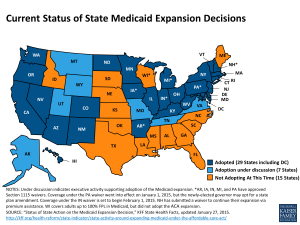Expert Witness Medicaid Expansion
As an expert witness in Medicaid Expansion I am regularly requested to provide opinions regarding the value of medical care under the Affordable Care Act. Expert witness Medicaid expansion must understand eligibility criteria including household income, disability, and Federal Poverty Level (FPL) guidelines. An Expert Witness in Medicaid Eligibility should be able to articulate what benefits are covered and variations in care at State levels, related to benefits available to the insured. Expert witness Medicaid expansion roles may include opinions regarding maximum out of pocket costs to a Plaintiff, benefits covered in life care plans in personal injury or medical malpractice, disability benefits, or Children’s Health Insurance Program (CHIP) which provides insurance coverage to uninsured, low-income children above Medicaid income eligibility thresholds. States are permitted to use CHIP funds to create a Separate CHIP program, expand their Medicaid program (Medicaid Expansion), or adopt a Combination approach.

A misunderstood and often overlooked centerpiece of the Patient Protection and Affordable Care Act—often referred to as “Obamacare” or “ACA”—is the expansion of Medicaid eligibility to people with annual incomes below 138 percent of the federal poverty level.
Medicaid, the national health insurance program for low-income people, is administered by States. As of January 2016, 31 states were expanding their Medicaid programs. Medicaid eligibility for adults in states expanding their programs has rapidly expanded the number of total insureds. Several factors must be considered including waivers, special programs for women, number of people living in the household and other factors along with Minimum Essential Coverage (“MEC”). Employers and employees have different considerations depending on which state they reside in, the disease categories and potentially other diagnosis characteristics.
Medicaid plays a critical role in providing health coverage for women (See National Women’s Law Center, Women and Medicaid in Nevada, February 2010). Nationally, nearly 17 million non elderly women were covered through Medicaid. Medicaid has different names in different states.
Nevada experienced one of the most significant increases in Medicaid insured beneficiaries. Nevada’s Governor Brian Sandoval announced in December 2012 that the state would expand Medicaid starting in 2014[iii]. Nevada expanded Medicaid in 2014 under the guidelines laid out in the ACA. As a result, there are 266,000 newly-eligible Nevada residents. From the fall of 2013 through June 2015, total net enrollment in Nevada’s Medicaid program increased by 69 percent. This is a much higher percentage increase than most states, and is second only to Kentucky, where Medicaid enrollment has increased by 84 percent[iv]. Nevada’s uninsured rate also fell by 24 percent from 2013 to the first half of 2015, going from 20 percent to 15.2 percent. The expanded access to Medicaid played a significant role in decreasing the uninsured population. According to the Reno Gazette Journal, “Many more Nevadans than expected enrolled in Medicaid after Gov. Brian Sandoval opted to expand eligibility, meaning the state will be paying more than projected once the federal government scales back its support. State officials said as of July 20, 2015 that 181,051 people are now receiving benefits as a direct result of the Republican governor’s decision, which extends Medicaid eligibility to all non-disabled adults with incomes at or below 138 percent of the federal poverty level — currently $16,243 for an individual.” The Federal Poverty Level is based on annual household income, which means that if an individual loses or gain income during the year their cost assistance eligibility can change.
[i] Source: http://gov.nv.gov/News-and-Media/Press/2012/Governor-Sandoval-Statement-on-Medicaid-Expansion/
[ii] Source: https://www.healthinsurance.org/nevada-medicaid/
[iii] Source: Kaiser Family Foundation, Women’s Health Insurance Coverage (Oct. 2009), http://kff.org/womens-health-policy/fact-sheet/womens-health-insurance-coverage-fact-sheet/
[iv] Kaiser Family Foundation, Health Insurance Coverage of Women Ages 18-64, by State, 2007-2008 (Oct. 2009), http://kff.org/womens-health-policy/fact-sheet/womens-health-insurance-coverage-fact-sheet/
Related Posts:
Medical Billing Expert Witness Howell and Collateral Source Rule
Medical Billing Expert Witness Howell and Collateral Source Rule

